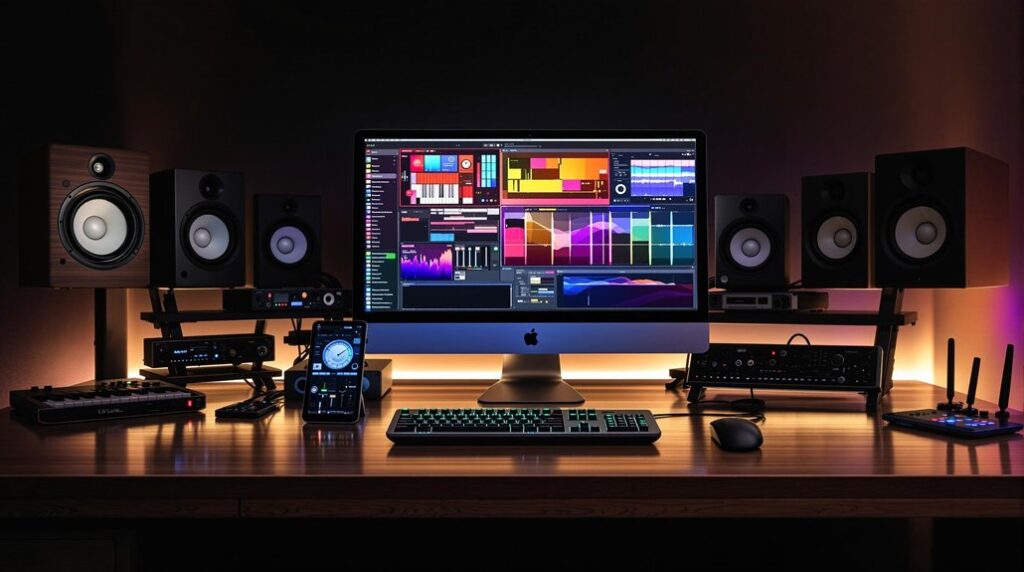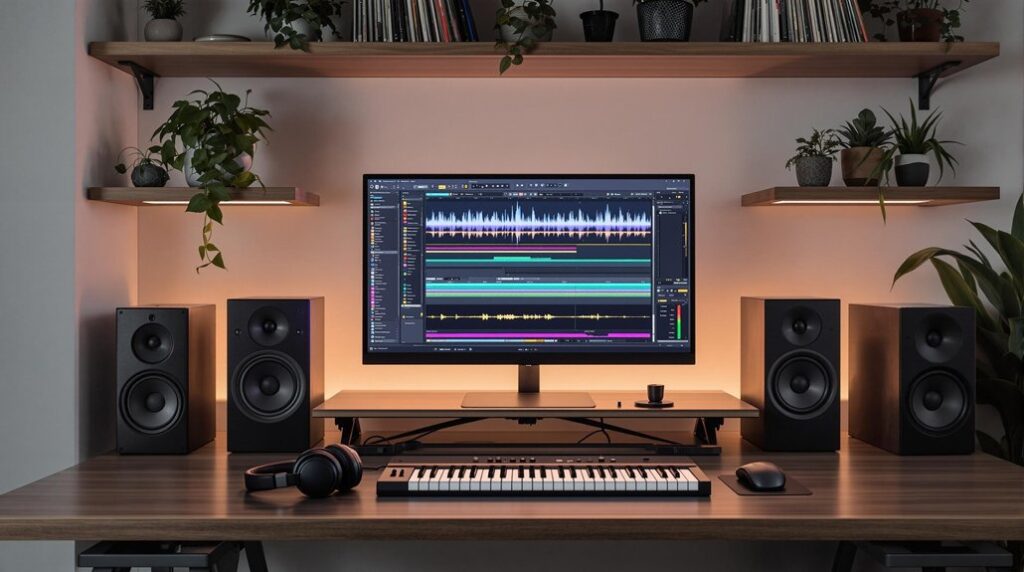To automate pitch in Ableton like a pro, start by setting up your audio track and accessing the clip view. Select “transposition” from the envelope dropdown and add break points for your desired pitch changes. Arm the automation button to manipulate pitch in real-time as the track plays. Click the record button to capture your expressive adjustments, monitoring the clip view for accuracy. Finally, refine your pitch modulation in the envelope section. For unique effects, consider combining automation with reverb or delay. Stick around, as there are more tips and tricks waiting to enhance your sound design even further.
Key Takeaways
- Open the audio track, access the clip view, and select “transposition” from the envelope dropdown menu for pitch automation setup.
- Add break points in the pitch envelope to define desired pitch changes and ensure smooth transitions.
- Arm the automation button and play the track while recording to manipulate pitch in real-time for expressive results.
- Refine pitch modulation by adjusting break points in the envelope section after recording to enhance accuracy.
- Experiment with combining pitch automation with effects like reverb and delay for richer, layered sounds.
Setting Up Audio Track
Setting up your audio track is pretty simple; just verify it’s configured to accept a sample for pitch modulation.
Double-click on the audio track to open the clip view, where you’ll find detailed editing options for your audio sample.
Next, click the dropdown menu to access envelopes, selecting “transposition” to display the break point envelope for pitch adjustments.
Familiarize yourself with the interface, as adding break points in the envelope will let you automate pitch changes effectively.
Remember to save your project regularly while setting up the audio track, so you don’t lose any progress in your automation setup.
Additionally, understanding how to manage plugins in your DAW can greatly enhance your audio processing capabilities.
Happy producing!
Automating Pitch
Automating pitch in Ableton Live opens up a world of creative possibilities, allowing you to shape your sound in unique ways. Here are some key steps to get you started:
- Create a live set and add an audio track.
- Access clip view and select “transposition” from the envelope dropdown.
- Set break points in the pitch envelope for smooth changes or dramatic shifts.
- Arm the automation button for real-time pitch manipulation.
- Experiment with spacing break points and combining automation with effects.
Utilizing pitch modulation techniques enhances your creative sound design and dynamic performance strategies. Additionally, mastering automation envelopes can significantly improve your ability to create intricate sonic textures.
After recording, don’t forget to review and edit your automation curves to refine those pitch adjustments and achieve the perfect effect. Let your creativity soar!
Recording Automation
Recording automation in Ableton Live allows you to capture your real-time pitch adjustments seamlessly. To get started, click the record button in the transport bar while your track plays. Use automation techniques by riding faders or adjusting knobs during playback, guaranteeing expressive pitch changes are recorded. Monitor your adjustments visually in clip view to confirm accuracy. Additionally, employing gain staging ensures that your pitch automation is free from distortion and preserves audio integrity.
| Recording Settings | Performance Tips |
|---|---|
| Arm the automation buttons for each parameter | Practice your adjustments beforehand for precision |
| Ascertain your track is in playback mode | Experiment with different fader movements |
| Check envelope section for editable curves | Record multiple takes for the best results |
After recording, refine your pitch modulation through the envelope section for polished automation.
Tips for Effective Automation
While diving into pitch automation, it’s essential to explore various techniques that enhance your sound design. Here are some tips to boost your automation game:
- Experiment with varying break points in the pitch envelope for unique sound effects.
- Use gradual pitch changes for smoother shifts, ensuring a polished sound.
- Combine pitch automation with reverb or delay for intriguing, layered sounds.
- Save your automation settings in project templates to streamline your workflow.
- Regularly check online resources for advanced creative modulation techniques.
- Consider incorporating sidechain compression to create dynamic interactions between sounds and enhance overall clarity.
Implementing these strategies won’t only refine your pitch envelope experimentation but also enrich your layering effects strategies, leading to a more professional and engaging production.
Additional Resources
To truly master pitch automation in Ableton Live, you’ll want to tap into a wealth of resources that can enhance your skills and broaden your creative horizons. Explore dedicated blog posts focused on pitch modulation techniques, which can deepen your understanding and introduce innovative approaches. Search for tutorials specifically addressing “how to automate pitch in Ableton Live” for step-by-step guidance. Watching video tutorials can visually demonstrate these processes, making concepts clearer. Engaging with online forums allows you to connect with experienced users who share valuable tips for automation workflow optimization. Finally, keep up with the latest features in Ableton Live to leverage advanced tools for creative sound design. Additionally, consider exploring advanced automation techniques to refine your pitch manipulation skills even further.
| Resource Type | Purpose | Recommended Actions |
|---|---|---|
| Blog Posts | Deepen understanding | Read and implement techniques |
| Video Tutorials | Visual learning | Follow along with projects |
| Online Forums | Community support | Ask questions, share tips |
| Step-by-Step Guides | Master skills | Practice regularly |
| Update Notifications | Stay informed | Explore new features |
Frequently Asked Questions
How Do You Pitch Correct in Ableton?
To pitch correct in Ableton, explore pitch correction techniques using MIDI pitch adjustments and vocal tuning methods. Utilize the “Pitch” effect, and consider plugins like Auto-Tune for precise, professional-sounding results that enhance your production.
How to Do an Automation in Ableton?
To automate in Ableton, explore automation techniques by adding automation lanes. Use envelope editing to define parameters over time, adjusting values for dynamic changes. Experiment with curves to achieve unique, expressive results in your audio projects.
How Do You Control Pitch in Ableton?
To control pitch in Ableton, you can use pitch modulation techniques, apply MIDI pitch adjustments, and implement vocal pitch correction. These methods guarantee precise tuning and enhance your overall sound quality in the mix.
Does Ableton Have a Pitch Shifter?
Yes, Ableton has a pitch shifter that enables real-time adjustments. You can explore various pitch shifting techniques for creative effects, blending original and modified sounds seamlessly to enhance your audio tracks effectively.
Conclusion
By following these five steps, you’re now equipped to automate pitch in Ableton like a pro. You’ve set up your audio track, mastered the automation process, and recorded your changes seamlessly. Remember, effective automation can enhance your sound, so don’t hesitate to experiment and refine your technique. With practice, you’ll reveal new creative possibilities. Immerse yourself in additional resources to further enhance your skills, and let your music soar to new heights!




